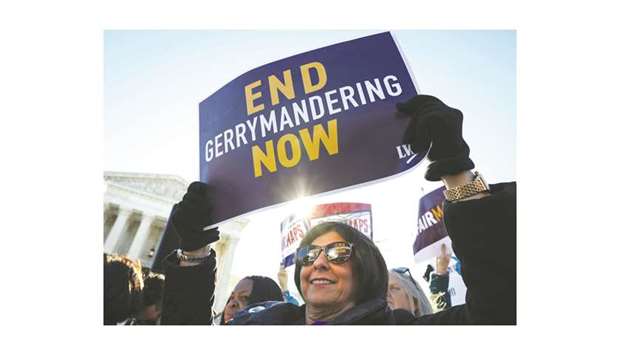Some conservative US Supreme Court justices yesterday signalled scepticism toward whether judges should have a role in curbing the contentious practice of manipulating electoral district boundaries to entrench one party in power, as the court appeared divided largely along ideological lines.
More than two hours of arguments in two major cases from North Carolina and Maryland showed that the justices were closely divided on whether courts can limit partisan gerrymandering, with the liberal justices appearing more sympathetic to the idea of intervening.
The high court has a 5-4 conservative majority.
Conservative Justice Brett Kavanaugh, who asked questions of both sides, could be the decisive vote in the rulings due by the end of June.
The justices last year failed to deliver a definitive ruling on the legality of partisan gerrymandering.
Yesterday, they got another chance in the cases before them challenging North Carolina’s Republican-drawn statewide US House of Representatives map and a single Democratic-drawn House district in Maryland.
“Why should we wade into this?” asked conservative Justice Neil Gorsuch, appointed by Republican President Donald Trump in 2017.
Critics have said gerrymandering has become increasingly effective and insidious by using precise voter data and powerful computer software.
The result in many states has been the creation of electoral districts, sometimes oddly shaped to include or exclude certain localities, that maximise one party’s chances of winning and diluting the clout of voters who tend to support the other party.
Gerrymandering also tends to foster the election of candidates with more extreme views at the expense of moderates, according to critics, adding to US political polarisation.
Conservatives Chief Justice John Roberts and Justice Samuel Alito also asked probing questions that indicated that they believed that electoral map drawing, an inherently political act, must be left to the legislatures not the courts.
Conservative Justice Brett Kavanaugh, a 2018 Trump appointee, signalled sympathy for both sides.
At one point he said he was “not going to dispute” the map challengers’ claim that partisan gerrymandering is a problem for democracy.
Kavanaugh asked whether the US Constitution could require “proportional representation” — with legislative seats gained proportional to the statewide vote’s party breakdown — to be used when districts being drawn.
That could imply he thinks that might be the basis of a possible test of the legality of a electoral map, although he also noted that other justices have previously said it does not.
But Kavanaugh like Gorsuch also wondered whether the Supreme Court needed to intervene when several states are coming up with solutions, including adopting independent redistricting commissions to handle political map drawing rather than legislators.
The two cases are among the most important that the court will consider in its current term.
The outcome could impact US elections for decades either by allowing federal courts to curb partisan gerrymandering or by removing their power to do so, giving gerrymandering-minded state legislators a freer hand.
About 150 people held an anti-gerrymandering rally in front of the court.
Some demonstrators held signs that said, “Unrig our democracy.”
Gerrymandering is carried out by cramming as many like-minded voters as possible into a small number of districts and spreading the rest in other districts too thinly to form a majority.
Plaintiffs in the two cases — Democratic voters in North Carolina and Republican voters in Maryland — have said the maps were drawn to diminish their voting power, violating their constitutional rights.
In both cases, lower courts ruled that the contested districts violated the US Constitution’s guarantee of equal protection under the law, the right to free speech and association, or constitutional provisions governing elections.
Legislative districts across the country are redrawn to reflect population changes determined by the federal census each decade.
In most states, redistricting is done by the party in power, though some assign the task to independent commissions in the interest of fairness.
While the Supreme Court has ruled in the past against gerrymandering intended to harm the electoral clout of racial minorities, it has never reined in gerrymandering carried out purely for partisan advantage.
The North Carolina case focuses on how Republican legislators reworked House districts in 2016 to ensure that 10 Republicans were elected to House seats, compared to just three Democrats, in a state whose voters are closely divided between the two parties.
“I think electing Republicans is better than electing Democrats,” Republican state House Representative David Lewis said at the time.
One of the plaintiffs’ attorneys, Allison Riggs, told the justices that the high court’s reputation could be harmed if it does not do something about such a blatant bias.
Liberal justices spoke of the unfairness of maps that allow a party to receive far fewer seats than their statewide vote tally would indicate.
When liberal Justice Elena Kagan noted that of thousands of simulated alternate maps for North Carolina, 99% were less biased than the one Republicans adopted, lawyer Paul Clement, who represents Republican lawmakers, said that merely demonstrated that map-making was discretionary and should be a political matter, not a judicial one.
“That’s making lemonade out of lemons,” Kagan replied.
Liberal Justice Sonia Sotomayor told Clement that politicians cannot discriminate against a group based on their political views.
In the Maryland case, Republican voters sued after the Democratic-controlled legislature redrew boundaries of their House district in a way that removed Republican-leaning areas and added Democratic-leaning areas. The move flipped the seat from Republican to Democrat.

Demonstrators protest during a Fair Maps rally outside the US Supreme Court yesterday.


